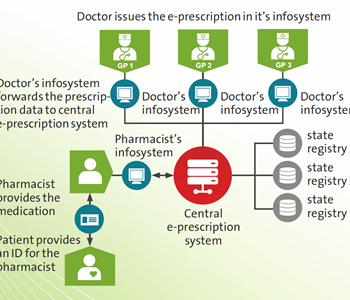Central ePrescription system and its interfaces
By 2013
Three years and 300 000 €

Hannes Danilov, the member of the board at the Health Insurance Fund
We are pleased to say that we have a digital prescription system that is a model for other countries
In the search for efficiency and excellence, the Estonian Health Insurance Fund and the Ministry of Social Affairs started the project of e-Prescription in Estonia.
The paper prescription system, that was in use before, wasted the time of all parties involved in the prescribing and buying/selling of medications.
The scarce resource of a doctor’s appointment time was wasted on writing recurring prescriptions and the patients had to spend time waiting for their appointment.
Some prescriptions would get lost, some would include the wrong percentage of subsidy by the Health Insurance Fund. The collection of statistics and data is costly and all parties must waste time on reporting the same data at different times. The new system was designed as a centralized and paperless system to be used by all doctors, patients and pharmacies.
The central system was developed. The information systems of medical practices and pharmacies were integrated and updated by their service providers. Also a central online interface for doctors and pharmacies who have less prescriptions to process or whose developments were not ready by the time of launching e-Prescription.
Many countries started their e-prescription projects before Estonia and have spent countless hours on establishing the system.
Estonia launched the e-prescription service in 2010 after three years of development and a software development budget of only 300 000 EUR.
The overall project lasted for five years including all the preparation necessary to issue prescriptions digitally.
The system was launched in the beginning of 2010 and by the end of the first year 84% of prescriptions were issued digitally.
Although the transition was not as smooth as planned, the uptake of e-prescription was very fast, because it instantly delivered convenience and saved time for all parties.
The digital prescription project involved a very big number of partners from different governmental bodies and registries, hospitals and medical personnel, pharmacies and their software providers.
All of the organisations had different technological platforms and standards, making the implementation of the system more complex.

From the organisational side a true challenge was that not all parties were committed to the transition, as their software development activities were not controlled by the project partners and were not centralised.
Although the project itself lasted for five years, the technical solution was developed in three years.
Despite the low quality of registries, limited time-frame and finances, Helmes was highly motivated and managed to create the most innovative Estonian e-health solution.
The project partners are proud to have provided the system in less time and budget than any other country has done until today.
e-Prescription has improved the openness and transparency in the area of the prescription of medicine and more importantly opened a whole new way for future developments which aim to share information and statistics and improve the medical care and also the quality of decision making among policy makers.
The central e-Prescription system enables medical personnel and pharmacies to monitor and manage the issuing of prescriptions. All hospitals and pharmacies in the nation are connected to the system.
When a doctor prescribes medicine using the system, he or she does so electronically, with the aid of an online form.
The system stores incoming prescriptions (messages) and sends patients’ prescriptions on demand to a pharmacy’s information system.
The e-prescription is then immediately accessible in every pharmacy on request.
There are three types of Digital Prescriptions:
- Private prescription – only the patient can use the prescription
- Delegated prescription – patient and nominated persons can use the prescription
- Public prescription – anybody who presents a valid ID and the patient’s ID code can use the prescription
The pharmacist, who is logged on to the system through the sales software or through the “X-tee” web portal, identifies a person using his/her ID card and receives the prescription from the central database.
If a person buys drugs for someone else, then it is necessary to know the personal identification code of the patient (provided that at the time of issuing, the prescription was classified as public).
E-Prescription
is the process of the electronic transfer of a prescription by a healthcare provider to a pharmacy for retrieval of the drug by the patient.
Patients have the possibility to follow the log attached to every prescription and see when and who has accessed the data.
Information about the purchase is submitted to the Digital Health Record.
Doctors are most appreciative of the system feature that enables the automatic calculation of the correct rate of reimbursement on medications compensated by the Health Insurance Fund.
As the ePrescription system draws on data from the national Health Insurance Fund, any state medical subsidies that the patient is entitled to also appear, and the medicine is discounted accordingly.
The doctor prescribes medication to the patient.
The system checks the Health Insurance Fund to see if there is any discount percentage for the prescription.
The prescription is then confirmed by the doctor and submitted to the register.
Furthermore, the system can provide an overview of the prescriptions issued for a patient by other doctors and the actual purchasing information regarding these prescriptions.
Automated processing of this information in the future helps to evaluate the interaction of pharmaceuticals prescribed by different doctors, patient adherence to treatment recommendations, misuse of medicaments, etc.
The project will make the health care system environmentally friendlier.
Since the data communications are digitized, it significantly reduces paper usage throughout the healthcare sector.
With approximately 8.000.000 prescriptions issued each year, the e-prescription solution enables the saving of a significant amount of time for all parties.
This frees up time for both the patient and the doctor, and reduces administrative strain on the hospital.
Doctors spend significantly less time issuing prescriptions.
They will get feedback as to whether the medication was actually purchased by the patient.
In terms of treatment, it is very important for doctors to know whether their patients have actually purchased the medications that have been prescribed to them.
If a patient’s health does not improve, then it is easier to know whether the problem is with unsuitable medication or with a patient who has simply not followed instructions.
The lives of doctors are simplified by the fact that the discount percentage is selected by the system.
The system protects doctors from unforeseen costs related to the inaccurate use of subsidies.
Pharmacies will spend significantly less time filling prescriptions and can pay more attention to serving clients.
For them, things are simplified by the fact that the greater part of prescription data on the prescription is already entered into the system by the doctor, which is why they are only required to add to the prescription information actual delivered medication and sales data.
In most cases this can be done using a barcode reader.
The prescription is then ready for e-invoicing to the Health Insurance Fund.
Patients no longer have to worry about carrying a paper prescription or losing the prescription.
Another major advantage of the system is that doctor visits are no longer needed for routine refills.
Patients with chronic illnesses needing a new prescription for their regular medication would only have to contact their doctor by e-mail, Skype or phone, and the doctor can issue refills with a couple clicks of the mouse.
After that, the patient can have the drugs collected from the pharmacy by a third party providing they have the patient’s ID number and show their own ID.
The Health Insurance Fund will be provided with fast and accurate reporting.
From the authorities’ perspective this means less paperwork, more time for individual patients, more reliable health statistics, better monitoring of compliance.
In May 2011, just 15 months after the launch, 84% of prescriptions are issued digitally.
More than 95% of pharmacies are ready to process ePrescriptions.
According to a survey "Citizens' satisfaction with health and healthcare", 97% of users of digital prescriptions are satisfied with the service.
Awards
Two of them
- The digital prescription ranked first in the category of ehealth and environment projects at an e-service contest, which included 71 new Estonian e-solutions. Thus the eprescription service is representing Estonian e-services in the World Summit Award of e-services.
- The Estonian Health Insurance Fund also received a Quality Innovation Award 2011 in the category 'public sector organisations' for the creation and implementation of the Estonian ePrescription system. The Quality Innovation Awards competition is open to the participation of Estonian, Finnish and Swedish organisations.
project sponsors

Estonian Health Insurance Fund
Url: www.haigekassa.ee
Their mission is to cover the costs of 1,2 million people for their health services, to help prevent and cure diseases, finance the purchase of medicinal products and medicinal technical aids, and provide the benefits for temporary incapacity for work and other benefits.

